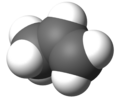Propene
(Redirected from Propylene)
Propene is an organic compound. The substance is also known as propylene and has the formula C3H6. It is the second-simplest alkene. Since it is only made of hydrogen and carbon atoms, it is a hydrocarbon. At room temperature and normal pressure it is a gas.
| Propene | |
|---|---|
| IUPAC name | Propene |
| Identifiers | |
| CAS number | |
| PubChem | |
| KEGG | C11505 |
| ChEBI | CHEBI:16052 |
| RTECS number | UC6740000 |
| SMILES | C=CC |
| Properties | |
| Molecular formula | C3H6 |
| Molar mass | 42.08 g mol-1 |
| Appearance | Colorless gas |
| Density | 1.81 kg/m3, gas (1.013 bar, 15 °C) 613.9 kg/m3, liquid |
| Melting point |
−185.2 °C, 88 K, -301 °F |
| Boiling point | |
| Solubility in water | 0.61 g/m3 |
| Viscosity | 8.34 µPa·s at 16.7 °C |
| Structure | |
| Dipole moment | 0.366 D (gas) |
| Hazards | |
| MSDS | External MSDS |
| Main hazards | Highly flammable, Asphyxiant |
| NFPA 704 |
|
| R-phrases | 12 |
| S-phrases | 9-16-33 |
| Flash point | −108 °C |
| Related compounds | |
| Related alkenes | Allyl, Propenyl |
| Related compounds | Propane, Propyne Propadiene, 1-Propanol 2-Propanol |
| Except where noted otherwise, data are given for materials in their standard state (at 25 °C, 100 kPa) | |
Uses
Propene is produced from fossil fuels, and from coal. Propene is the second most important product used in the petrochemical industry, after ethene. About two thirds are used to produce polypropylene. Propene and benzene are converted to acetone and phenol via the cumene process. Propene is also used to produce isopropanol (propan-2-ol), acrylonitrile, propylene oxide (epoxypropane) and epichlorohydrin.[1]
Propene Media
References
- ↑ Budavari, Susan, ed. (1996). "8034. Propylene". The Merck Index, Twelfth Edition. New Jersey: Merck & Co. pp. 1348–1349.
+{{{1}}}−{{{2}}}




